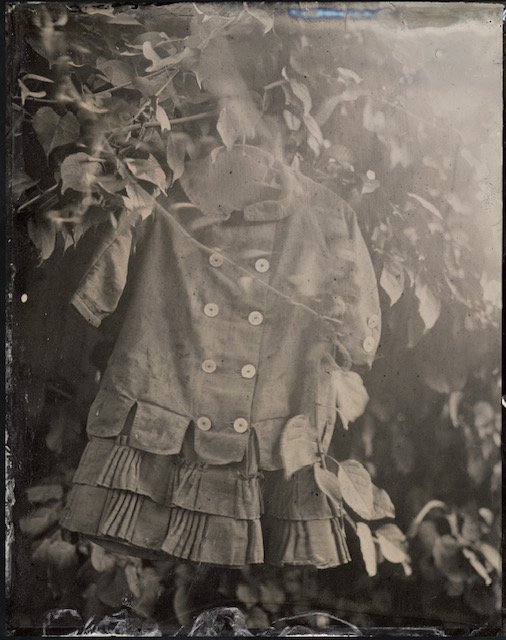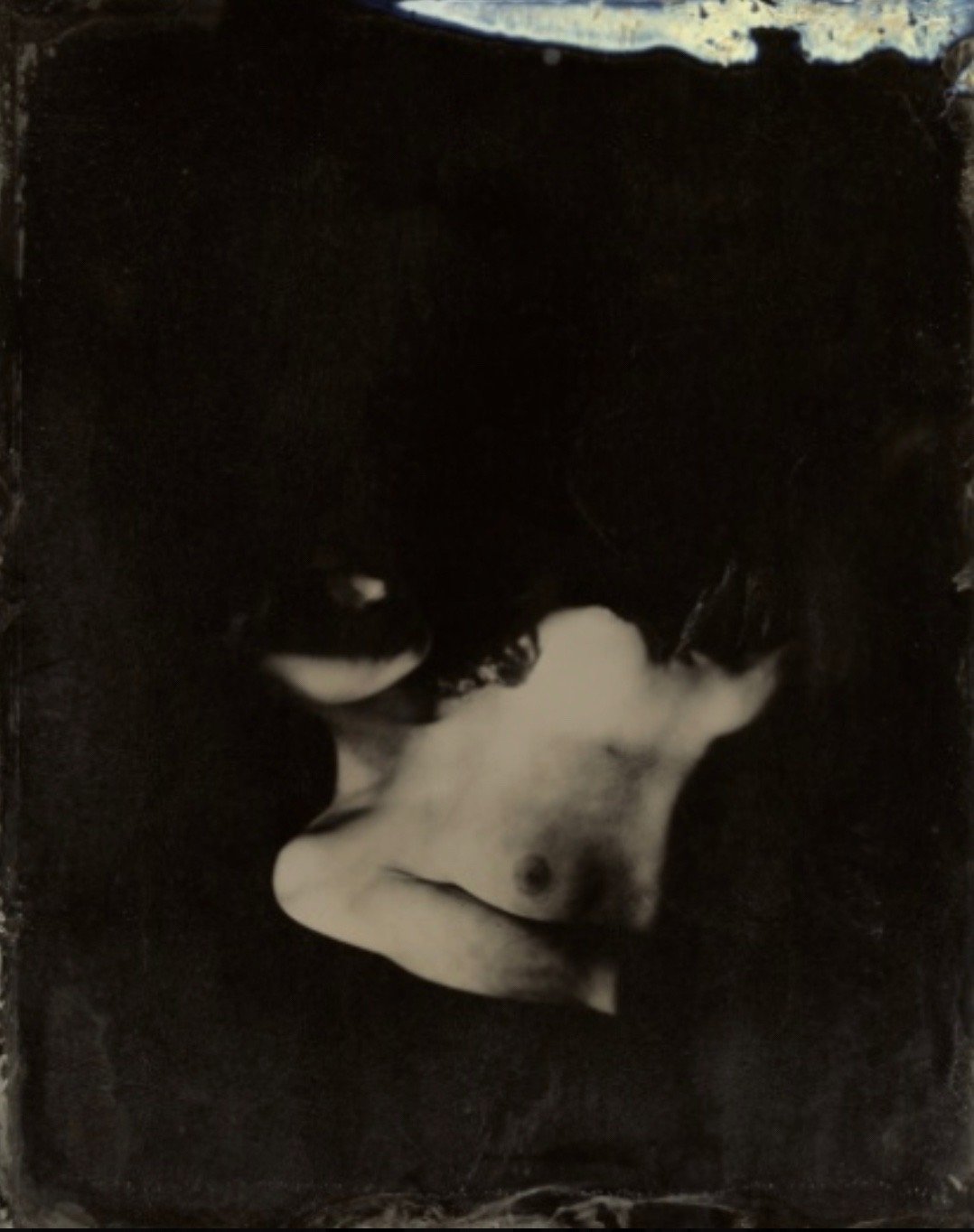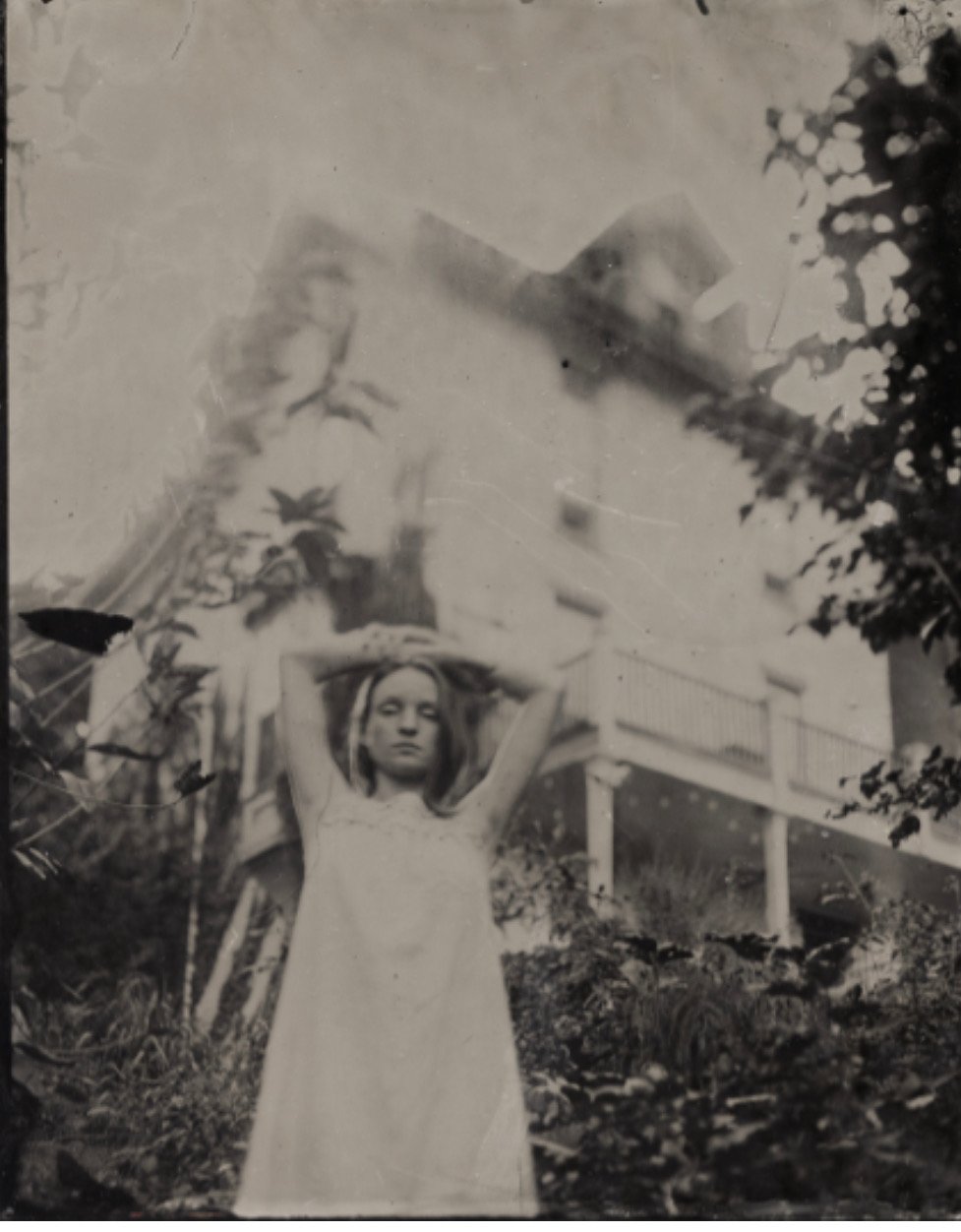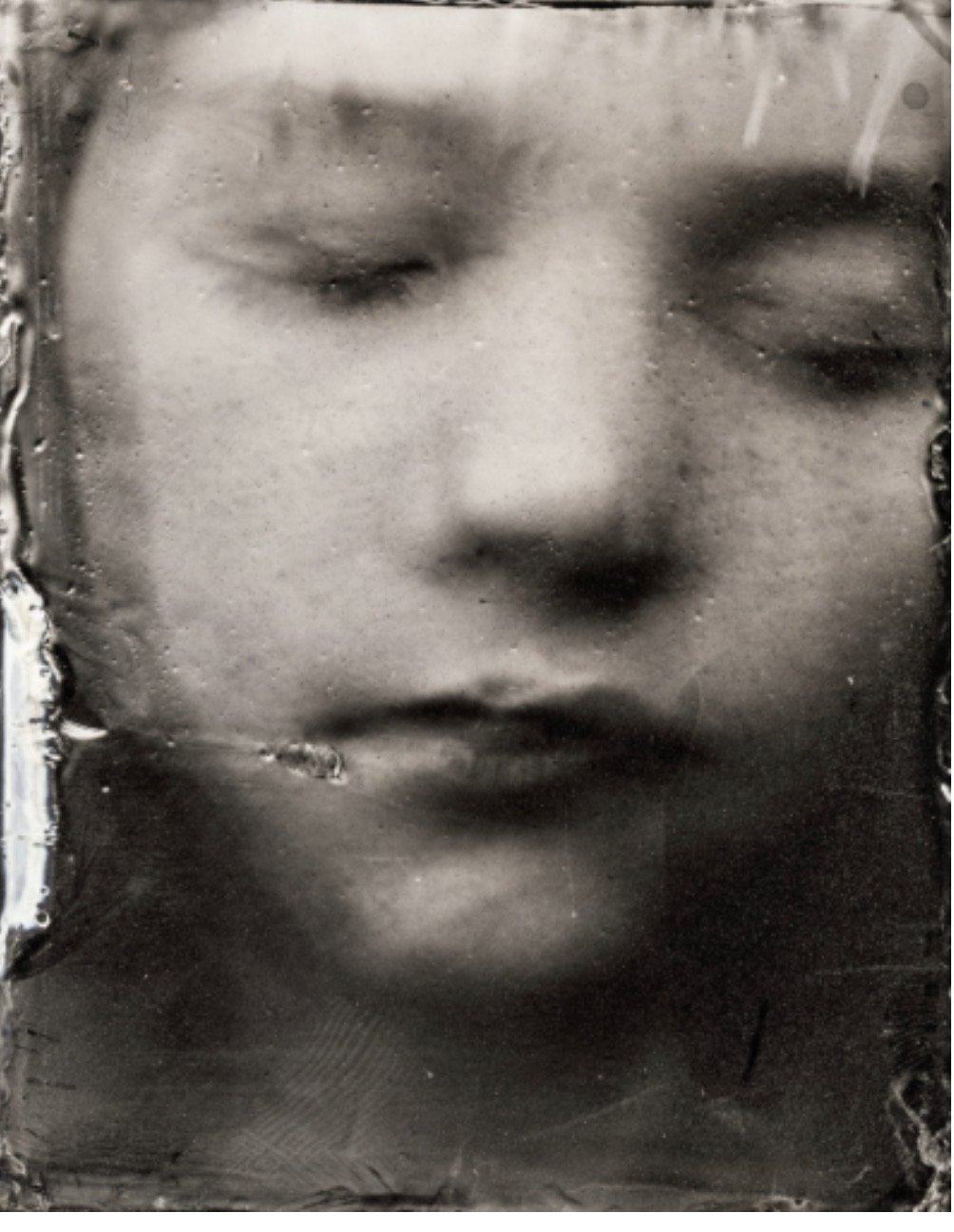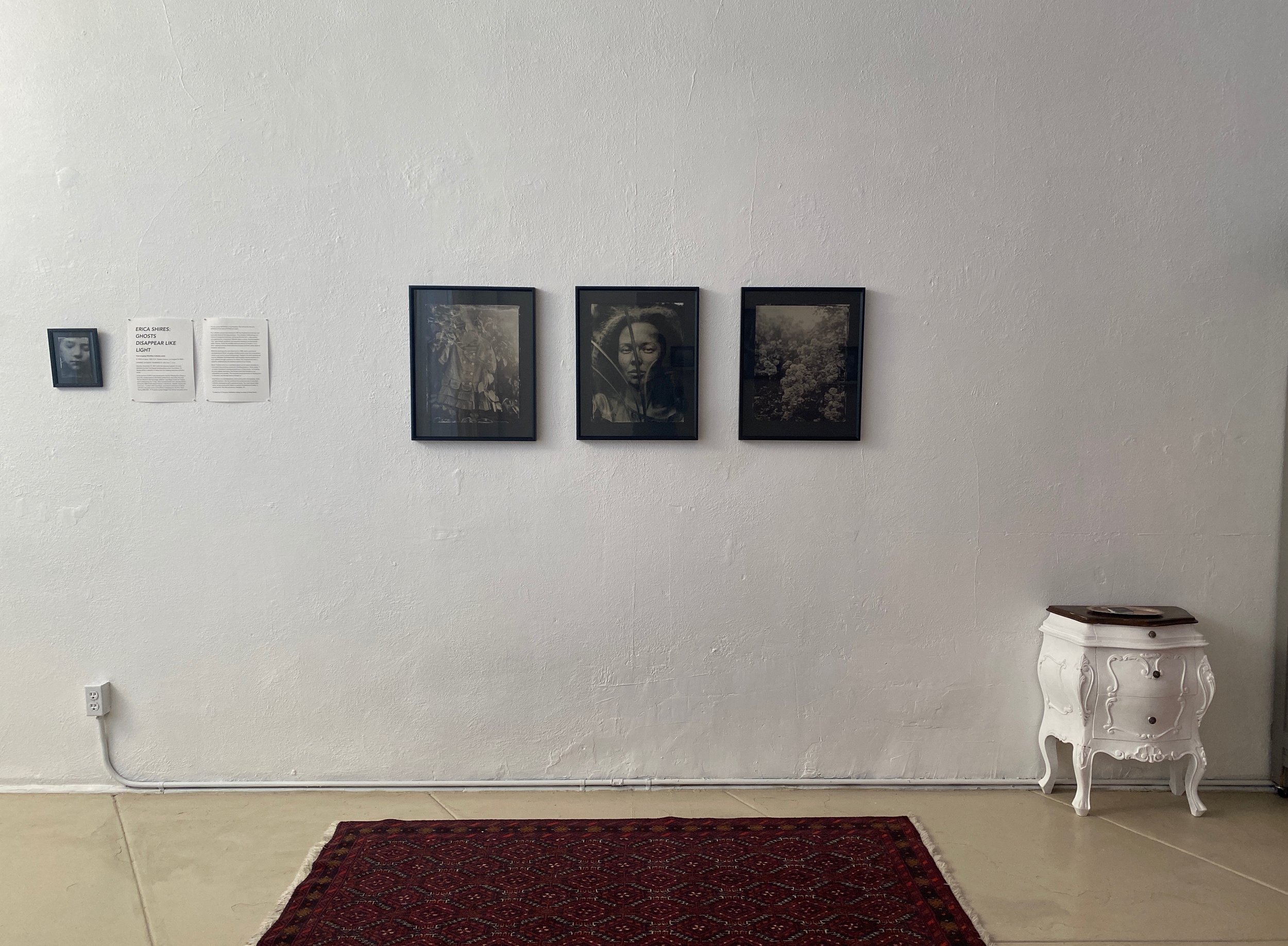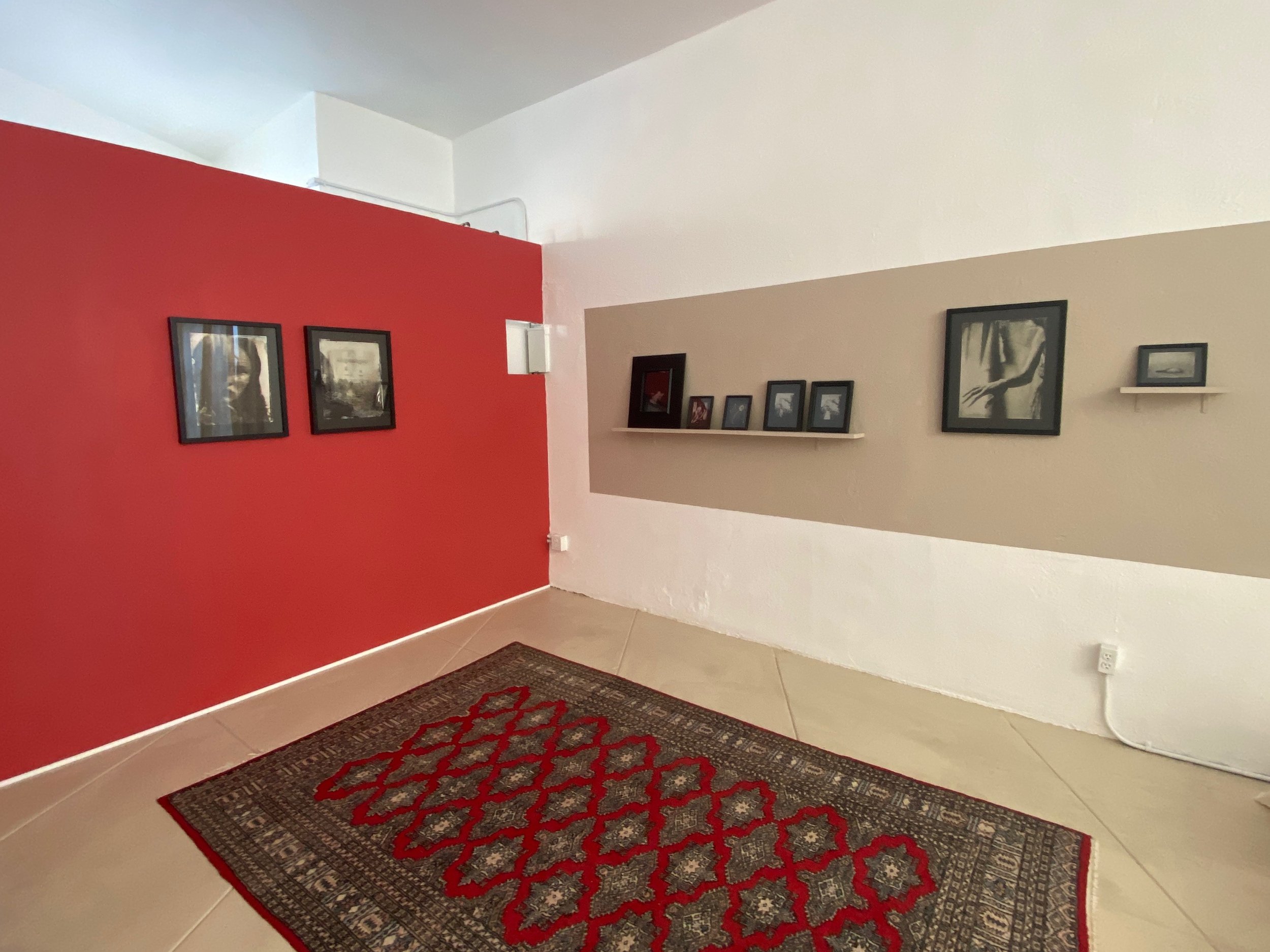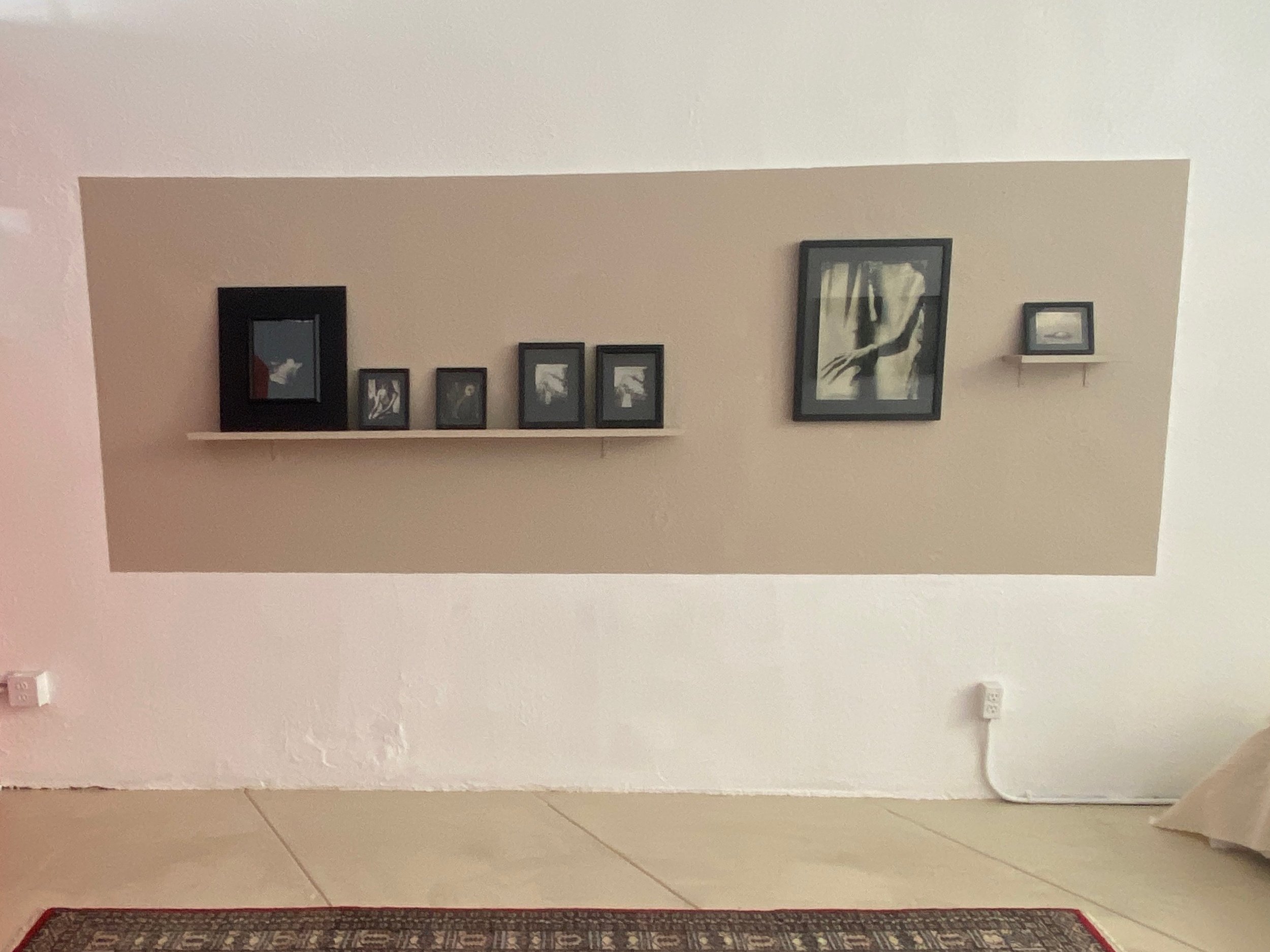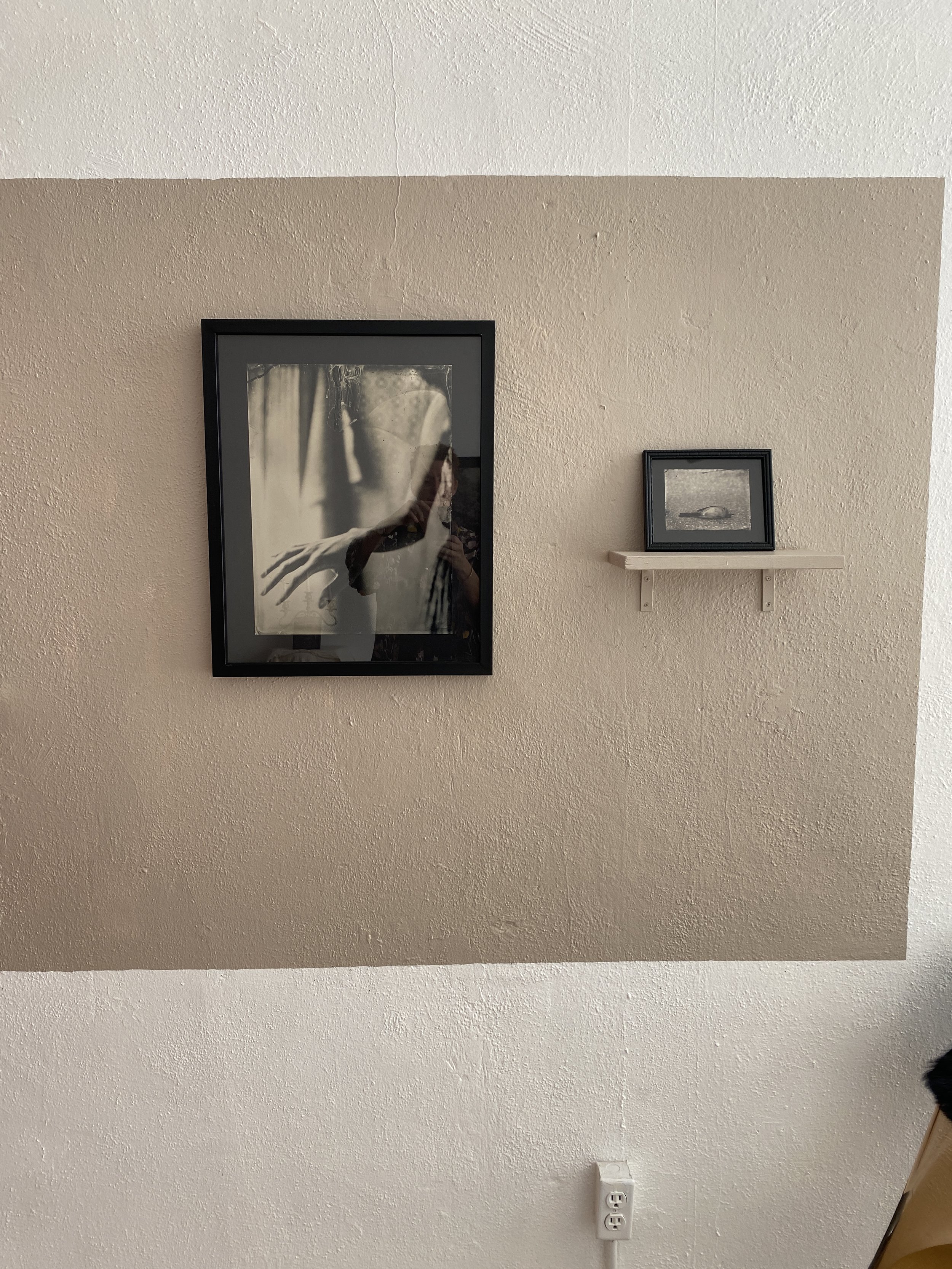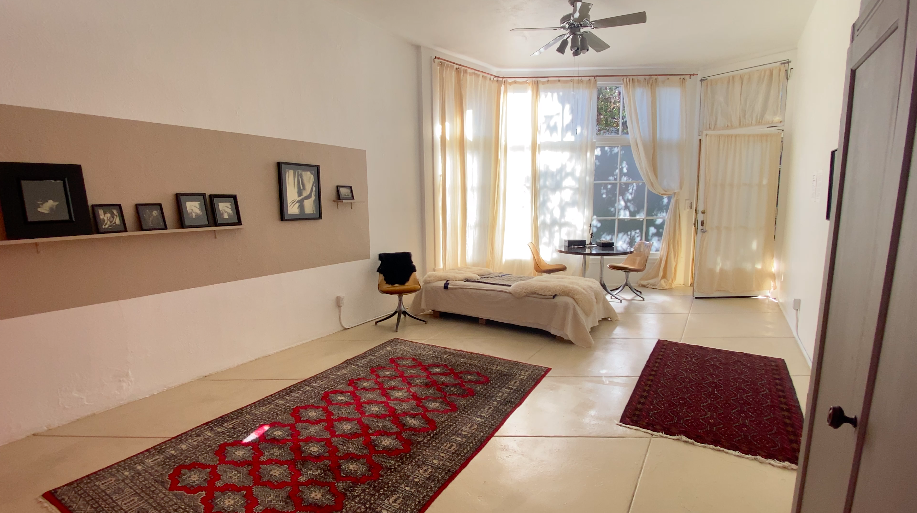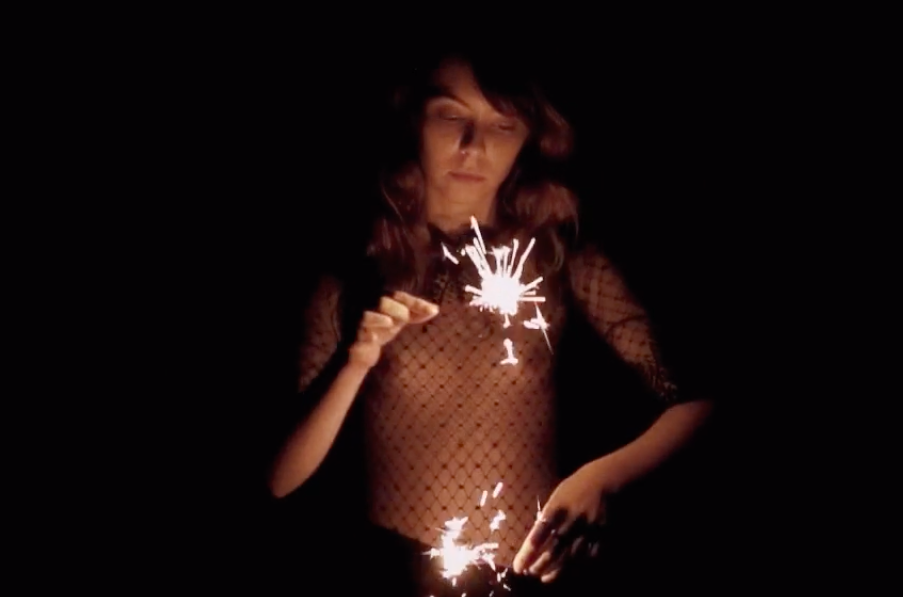From the ongoing Wet-Plate Collodion series
EL NIDO art space presented by VC Projects
1028 1/2 N. Western Avenue, Los Angeles CA 90029 | By appointment only
Opening Reception: Saturday, November 27, 2021, from 12 - 5 pm
Closing Reception: Saturday, January 8, 2022, from 1 - 4 pm
Exhibition dates: November 27, 2021 - January 14th, 2022
Saturday, November 27, 2021 marks the opening reception of a solo exhibition by New York based interdisciplinary artist, Erica Shires. On display will be a selection of works from her ongoing wet-plate collodion series.
In the summer of 2019, I was introduced to the film Silvia by Erica Shires, a short she collaborated on with Italian performance artist Silvia Morandi. The two filmed in the hauntingly aesthetic Casa Regis Center for Culture and Contemporary Art in Italy. Silvia received laurels from and was shown during the 2020 Screen Dance Festival in Stockholm, Sweden. During the same year, I worked with Casa Regis, to present a selection of Shires’ collodion wet-plate series at Fotofever Contemporary Art Fair, at the Carrousel du Louvre in Paris. During 2020-2021, VC Projects curated images from Shires’ wet-plate series into two group exhibitions in Los Angeles. This will be the first solo exhibition of her work at El Nido art space.
The collodion process was invented in 1851 by Frederick Scott Archer and eventually replaced the daguerreotype. The collodion methodology is a mixture of preparing chemicals, setting up the shot with a view camera, and capturing the composition. Whether glass or metal, the photographic "film" gets coated, sensitized, and exposed, needing to be developed within minutes, inside the portable darkroom set-up on location. It is a labor-intensive process where elements of space and time create layers of metaphor and poetry.
While the technique she uses dates back to 1850, what is particularly admirable about Shires’ wet-plate collodion series is how the compositions relate to our current cultural anthropology. Gazing at the work reminds one that this adaptable illuminated field might possibly capture evidence of a soul, whether through a person or an object. Her compositions mark a quest for understanding the essential essence of our beings.
Shires’ finished work has a crystalized aspect, as the viewer witnesses an inner world documenting a particular vibrating existence. Shires states, “I am never interested in portraying anything in a literal sense. I am looking for some deeper resonance, that liminal space that touches on our vulnerability and mortality. This wet-plate series examines our fleeting time in this world, and the way sorrow changes us.”
Erica Shires is an interdisciplinary artist working with photography, video, and 3D animation. She has combined the archaic process of wet-plate collodion photography with augmented reality. Her most recent video works connect analog with digital to explore the elasticity of reality in virtual worlds. She lives and works in Brooklyn, NY.
Special thanks to Los Angeles-based Greg Smith for exhibition design.
208 Montgomery St,, (2016), 2021, Wet-plate collodion on aluminum, scanned and printed on metallic silver archival paper, 12 x 16 inches, edition of 8 + 2 AP
She Found This in London, (2016), 2021, Wet-plate collodion on aluminum, scanned and printed on metallic silver archival paper, 12 x 16 inches, edition of 8 + 2 AP
Last Days, (2016), 2020, Wet-plate collodion on aluminum, scanned and printed on metallic silver archival paper, 4 x 5 inches, open edition
My Favorite Rose Bush, (2016), 2021, Wet-plate collodion on aluminum, scanned and printed on metallic silver archival paper, 12 x 16 inches, edition of 8 + 2 AP
Death, (2006), 2021, Wet-plate collodion on aluminum, scanned and printed on metallic silver archival paper, 12 x 16 inches, edition of 8 + 2 AP
Paulina, (2016), 2021, Wet-plate collodion on aluminum, scanned and printed on metallic silver archival paper, 12 x 16 inches, edition of 8 + 2 AP
Love, (2018), 2021, Wet-plate collodion on aluminum, scanned and printed on metallic silver archival paper, 5 x 4 inches, open edition
L, (2016), 2020 Wet-plate collodion on aluminum, scanned and printed on metallic silver archival paper, 10 x 8 inches, edition of 8 + 2 AP
Last Days II, (2016), 2020, Wet-plate collodion on aluminum, scanned and printed on metallic silver archival paper, 4 x 5 inches, open edition
Morte, (2016), 2020, Wet-plate collodion on aluminum, scanned and printed on metallic silver archival paper, 4 x 5 inches, open edition
Heather, (2016), 2020, Ambrotype (wet-plate collodion on black iridescent glass) 4 x 5 inches. Printed by the artist from scan - open edition
Maxine, (2015), 2020, Wet-plate collodion on aluminum, scanned and printed on metallic silver archival paper, 4 x 5 inches, open edition
INSTALLATION SHOTS - please click on the image to move to the next slide
BIOGRAPHY
Erica Shires is an interdisciplinary artist working with photography, video, and 3D animation. She has combined the archaic process of wet-plate collodion photography with augmented reality. Her most recent video works connect analog with digital to explore the elasticity of reality in virtual worlds. She lives and works in Brooklyn, NY.
BELOW: Special feature for online viewing - select FILMS by Erica Shires:
WATCH VIDEO “SYLVIA”
WATCH “CAROUSEL”
WATCH “POLINA”
WATCH “INSIDE A ROOM I THOUGHT I’D LOCKED”
WATCH “LITTLE POEMS”
MORE about the collodion process, below Erica’s camera and chemicals
One of Erica's cameras: Eastman (Kodak) 8 x 10
Inside Erica's Brooklyn based studio, a view of her chemicals
INTERVIEW WITH ERICA SHIRES
A Note from the Curator:
To explore Erica's artistic practice, I will be sharing interview questions proposed to Erica about inquiry, composition, and technical aspects over the next few weeks. We did the interview over email and will continue throughout the exhibition. I am submitting questions, receiving answers - a sort of dance, if you will, back and forth. I feel it's essential to provide insight into the work on display and a deeper understanding of the artist's intent. I hope you enjoy this segment of the exhibition.
Victoria Chapman (VC)
EL NIDO art space presented by VC Projects
PREFACE
What is equally fascinating about Erica's work is two-fold; In this series, she is using the wet-plate collodion process from 1851. It is laborious, necessitating procuring and mixing chemicals, preparing and sensitizing each plate, setting up the image with a large-format view camera, exposing the plate, and finishing the final stages in a portable darkroom on-site. From start to finish, this must be completed before the plate dries - within approximately 10 minutes. Secondly, though this is a historical process, her compositional aesthetics are current and how she arrives at creating the finished works based on intuition is truly remarkable. Erica has a unique aesthetic in combining the process into the final results to share an unmasked vision pertaining to the truth about our immediate existence.
INTERVIEW
VC: To begin with, it’s a great pleasure to have you at El Nido. I have curated your work in two group exhibitions here in Los Angeles and had the opportunity to assist with presenting your work at Fotofever during Paris Photo. Over these past three years, I have reflected on numerous compositions and have great admiration regarding the technical aspects of this ongoing series. As an interdisciplinary artist, working in photography, video, and augmented reality, what is it about the collodion process that has you coming back for more?
Erica Shires: It would have to be the physical aspects involved in the process, and that it takes me back to my photographic roots. It feels pure. I miss making things with my hands when I am on the computer for long stretches of time. I have also found that it is still relevant in the work I am producing now. I have been using it to document animals during different stages of my taxidermy process. I have also combined wet-plates with AR (augmented reality) to create little secrets for people who buy my work.
VC: Gazing at the work, Ghosts, I am impressed by the depth of the portrait, there is a certain longing or need to touch the photo. I am also in love with what might be considered the “sensitized and exposed treatment”. Would you be willing to share something about how this was made? Leading to or the aftermath?
Erica Shires: "Ghosts" was shot in a studio I used to have on Broadway near White Street in downtown New York. I was shooting a lot of tests for modeling agencies, and if I had time after a session, I would shoot a wet-plate or two of each girl. My studio was less than ideal for shooting collodion — it was narrow with low light, which necessitated long exposures that sometimes exceeded a minute. I had a wooden box off to the side as my tiny DIY darkroom and the glass I had cut, while clean, was left out in racks to collect dust. The limitations I was working under and my intentional jeopardizing of the "perfect" plate created the random imperfections that cover this image. I consider these chemical defects layers of emotional material that interface with the liminal.
VC: During the opening reception, My Favorite Rose Bush was a favorite amongst many guests, tell us something about this image.
Erica Shires: This was a very old rose bush in my backyard. It grew wild over a fence, bloomed prolifically, and was the most unusual subtle shade of pink - bright and faded at the same time. I have no idea when they were planted, but the house was built in 1850.
VC: In working with this medium how do you get to what Henri Cartier Bresson called: “The Decisive Moment?” Is there a certain amount of waiting, and then a great rush to prepare the plate coating it, sensitizing, and exposing?
Erica Shires: With collodion, I have to set up the shot and focus the camera before pulling my plate from the silver bath in the dark-box. I must quickly take the picture due to the time constraints imposed by the chemicals drying out, thus killing the plate. Maybe the model moves, or I bump the camera and accidentally change the composition. There are always unintentional happy accidents in this process for me.
The photographer Sarah Moon said it perfectly: “Yes, the moment that might or might not happen. The gift that doesn’t depend on us. The best we can do is be ready – and that’s the hardest. All the efforts we invest, the intensity, the waiting, the hoping are not enough. Ultimately, what makes me press the shutter is a feeling of recognition. As if suddenly I felt: yes, that’s it! I recognize something that I had never seen until that moment, that is beyond all my intentions.
And though with wet-plate I don’t have much lateral on deciding when to press the shutter, I very intentionally experiment with every step of the collodion process to invite serendipity.
VC: The work L has a unique abstract quality; the blacks are super velvety. How did you plan for this?
Erica Shires: It’s funny, but as much as I try, I can’t deliberately plan outcomes when I am shooting wet-plate. I am constantly surprised by what I am given. L. was lying in the shadows of my entryway, and sunlight streamed in through a window. Such a wide exposure latitude between the lights and darks would be impossible to capture, and because wet-plate collodion has approximately an ASA of 2, I am guessing this was a 30-sec exposure. Only the bright parts of her registered on the plate; the rest fell off into darkness. That velvety black is how a wholly underexposed area of a plate looks. And sometimes that works, not because I knew what I would get, but because I shoot fast and experiment to see how something might look without worrying if the plate will be successful.
VC: Creativity is usually defined as a language or thinking that speaks outside society's norms. Is yours found in random objects or within the rural or city landscape where you often find yourself?
Erica Shires: For me, creativity comes from a place of wonder. I am constantly amazed living in NYC. The scale of everything reminds me of how things felt as a child and daily life here, commuting into the city on the ferry, riding the Vespa across the Manhattan Bridge when I can catch a ride home with my husband, walking and walking and all the museums and galleries and friends - it is a big playground. But when I need to make work, I tend to disappear into a location that’s not urban and hopefully for an extended period of time without interruptions. I crave nature and wild, atmospheric landscapes. Right now, I am in development for a project in Newfoundland.
VC: The work, She Found This in London, explores a jacket amongst some bushes. Can you tell us something about the process of this work?
Erica Shires: It is an antique child’s coat gifted to me by my friend Aurora. I love the handmade craftsmanship, its blue color, and all the marks of time. I have photographed it many times, both indoors and out. This was shot in my backyard just up the fence from my favorite rose bush.
VC: Regarding the work titled: Polina – from my research about the collodion process, during the exposure time, the sitter must be very still, they can blink and breathe, and that’s about it! What was your exposure time on this portrait, and was this captured in nature or the studio?
Erica Shires: I don’t remember the exact exposure time, but it must not have been very long. Five seconds maybe? I shot this outside at 208 Montgomery — which is the image of the house in this exhibition.
PART 2 INTERVIEW WITH ERICA SHIRES
A discussion about film, learning more about the artist’s oeuvre
At this point of the interview we switch gears and focus on Erica Shires filmmaking, which at times incorporates animation and even augmented reality.
VC: When researching your art-making career, I learned that you have been working with the collodion process for sixteen years - but that’s not all you have done. I was initially introduced to your work through video. At this juncture of the exhibition, I feel it’s equally important to share the depth of your filmmaking, a great deal of which is on Vimeo. During this interview segment, I would like to explore this side of your creative process. On our website, and below, I have curated five short films: Sylvia, Carousel, Polina, Inside a Room I’d Thought I Locked, and Little Poems.
My first choice is Sylvia, a romantic, and mesmerizing work, please tell me more about how this film came about. Can you provide us with some insight into your choreography and film methods?
Erica Shires: I had just met Sylvia that day. She came up to our house in Newburgh to spend the night so we could make work together. Heather, there is a wet-plate of her in the exhibition, is a stylist, and she had found this cute dress for me to shoot Sylvia in. I think there was only one take of the sparklers burning well, from beginning to end, and that is what I used. I reversed the footage so the fire drips were falling up and I also edited the music backward. Can you guess the song?
VC: A collaboration of sound in tandem with the moving picture seems to be a fundamental feature of your films. What is your relationship with music?
Erica Shires: Sound has always been a thoughtfully specific and deliberate component in my work. Lately, I have been making field recordings wherever I go. I am compiling quite an extensive sound library. One of my latest favorite sounds is an old car that starts up on our street late at night, which I finally got up to record. Its droning became a beautiful, sorrowful song I used in my thesis work. Most of the original music in my videos was created by Miguel Santos, an incredible Portuguese composer. His wife Johanna is a frequent traveling companion and collaborator and appears in many of my works.
VC: How do you decipher which medium to work in when inspired by an idea?
Erica Shires: I ask myself - how much time do I have, and what is this for? I tend to document in as many mediums as possible. I will shoot stills, polaroids, and video and have for years. Lately, I have been making 3D scans of body parts. I am gathering as much information as possible from the day for raw material to experiment with later. I often don’t specifically know what I am making; I am just trusting my process. If I am lucky, have the time, and my dark-box is set up, I will also shoot wet-plate.
VC: The film Carousel has a striking contrast between film and animation, and I love the hypnotic experience playing back and forth. Then there is the variation of the tree, which is quite fascinating. I also respect your willingness to interpret a carousel in this day and age. This work is quite cerebral, reminding me of my childhood on a carousel going round and round. I remember them on playgrounds as a child and in parks. Can you tell me something more about the antithesis of this work and what you hoped the viewer might experience?
Erica Shires: Carousel is an interactive-piece-as-performance, controlled by a user. I made it in graduate school while I was learning basic coding in p5.js. I later made this small video to show one version, but in reality, the piece takes its form by the person navigating with the mouse. It is different with each interaction. The footage I used as a skin is of winter trees that I shot out my car window and then changed the colors to mimic a cyanotype. The music is not mine but what I used during the original presentation.
VC: While searching on Vimeo, I found the short titled: Polina. It appears to be the same “Polina” in the wet-plate collodion series featured in the “Ghosts Disappear Like Light” exhibition. How does the collodion process inform your film inquiries when working from a still image to a moving picture?
Erica Shires: It is the same Polina. If possible, I incorporate shooting plates and filming video when hanging out with friends. It is all a circle and the collodion process is a tangent that takes me away from monitors. So much of my work is digital and ephemeral, and the wet plate images feel substantial, like little anchors that keep my digital work grounded.
VC: What are your goals in filmmaking? Each work I have shared here has a different element and a common thread, similar to your collodion process. Inside a Room I thought I’d Locked is an incredible portrait sharing passion and conflict. It made me think about the battle living between inner and outer realities we are hopelessly locked in.
Erica Shires: Alexzandria wrote that song and sang it while playing on my piano. She is an artist that lived at our place for a while. It was a super creative and uncertain time for both of us. We made that to submit as an artist video, but alas, it was never selected.
VC: My last choice was Little Poems, I found myself watching this short over and over, searching for the hidden messages within each poem. Tell me about the scene with the seagull.
Erica Shires: It was a freezing, snowy day, and I decided to go down to the Hudson River and film. There were dozens of seagulls there, and they surrounded me. It was magical. I have recently wanted to find the rest of that footage to see everything I shot that day. I have a GIF of those seagulls on Giphy, and it has well over a million views. Those seagulls were photogenic!
VC: Are there any particular aspects in film you are hoping to investigate that you haven’t been able to attain yet?
Erica Shires: I want to dig even deeper into creating work in the game engine, synthesizing photographic history, theory and practice with these new technologies. And to see my work exhibited as a large-scale, multi-channel video and sound installation.
PART 3 INTERVIEW WITH ERICA SHIRES
Back to the collodion process
VC: Returning to your collodion process, and works in the current exhibition, Ghosts Disappear Like Light, there are a few more works I would like to further contemplate a deeper understanding of. The first is 208 Montgomery Street, there is a golden hue to this work, and even though you captured this in 2016, there is an old feeling about it. So many of our guests to the exhibition have been intrigued with the composition’s essence. Can you add something more about this work?
Erica Shires: This image of my house from the backyard was overexposed. I also intentionally solarized it, which means that after I shot the plate, I exposed it to light during development - similar to what Lee Miller and Man Ray did in the darkroom. The house was built in 1850, paralleling the invention of collodion wet-plate photography. Adding to the overall atmosphere was the personal fact that I was in the process of moving, and it was a time of numbness. This frenzied shooting period was me grasping tiny moments to hold on to; I was saying goodbye to a place and a time that was fading away.
VC: Let’s discuss Last Days I and II. I placed these works next to each other in the exhibition. I admire how we see the woman nude in the foreground of 208 Montgomery St. There is a sense of pride and vulnerability in the woman. In the second image, the woman has clothes on, still standing in the foreground of the same house. Both compositions seem independent of each other, yet at the same time, they resemble something that is the same until one looks at the woman. The nude figure seems more relaxed than the clothed one. I recently listened to an old episode of John Berger regarding “seeing” and how he felt the nude is interpreted as another form of identifying a specific pose. It no longer has the transparency or vulnerability quality of being nude. Instead, ‘nudes’ in photography are sought after so frequently, and it is just another way of identifying beauty; it’s another costume for women to adhere to. What were your thoughts about the nude in Last Days?
Erica Shires: I don’t think the nude of D. would be construed as a costume in the same way it might if a man had made these images. During that time, so much of my work explored nudity. The young women I documented possessed such confident power, and I gave them the freedom to direct themselves in our process. I was also shooting a lot of repetition - clothing on and off and multiple wet plates, stills, and video of the same scene. Every plate would invariably come out differently, to be further informed by all of the different mediums I was using. These images of D. were from my last days living there.
VC: Love is a very different composition. I have shown a few of your still life works in Paris and another group exhibition in Los Angeles, but this is the first solo exhibit where your work surrounds me. I had a collector come in during the opening reception and acquire it right away. Can you share something about this work?
Erica Shires: My sister had just died unexpectedly, and I was in mourning. These flowers were some of the first wet plate images I made afterward. I had been watching them fade and wilt and wanted to retain something of their existence before they died.
VC: You shared with me you also do some taxidermy work. Morte seems to be directly related to that. It’s a fragile but genuine claim to existence. This work is incredibly poetic, and once again, I had a collector come and acquire it right away.
Erica Shires: I didn’t start teaching myself taxidermy until 2019, but when I lived part-time in Newburgh, I seemed to acquire many dead animals. I’d find them in my yard or on walks down to the Hudson River; neighbors even brought me a few. I would always try to photograph them, and if I didn’t have time, I’d save them in my freezer. This dead bird was so sweet and perfect. No ants had found it yet. I love how the legs resemble little skeleton hands.
VC: There are many notable works, Death being another that captivated my heart. Years ago, I read about dying. While we might contemplate death, I learned that one is really examining life and what it means to be alive. To me, this image shares the pulse of life and perhaps the transition, which might soon be death. What were your thoughts? Did you set out to capture this, or was it as spontaneous as life itself? The residue from the collodion process is quite remarkable.
Erica Shires: Death is one of my first ever wet-plate images. It is actually of L., a dear friend with a chronic illness that I have been documenting for a very long time. Working with her always manifests in ways that transcend the here and now. Visual queries into death have fluttered through much of my work. This thread winds its way through a vulnerable place that seems to exist alongside us. We remember intertwined ghosts and feel essences, some living only through old family photographs that look a certain way and feel like memories we know. These ghosts of our own lives gather and fade, blown away by time.
***


